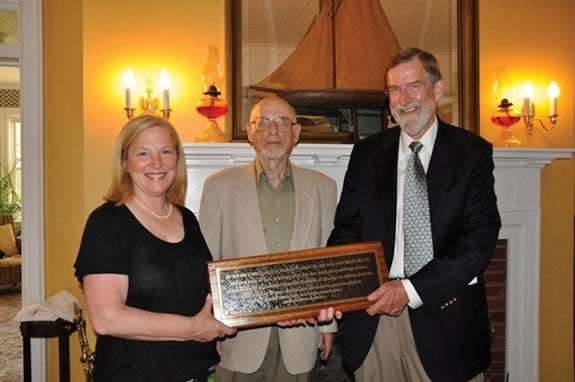Ram's Head Inn
Shelter Island Heights, New York

On June 2, 1947, Oppenheimer, Feynman, Teller, Lamb, Rabi, Pauling, Bethe, and 17 other physicists secluded themselves in an inn on an island off the east coast of the US. They attacked quantum mechanics problems with the voracity of pirates plundering an enemy ship’s trove.Three days later, the scientists emerged victoriously with a booty that was far more valuable to them than any shiny doubloons: they had tackled some of the most perplexing mysteries of physics. In doing so, they put Shelter Island, just off of Long Island, NY, on the map of monuments of physics historical importance.
On June 4, 2010, APS Editor in Chief Gene Sprouse presented a plaque to the proprietors of the Ram’s Head Inn, in recognition of the Shelter Island Conference that contributed so much to modern scientific thought. The citation reads: “At this site a small meeting of theoretical physicists took place June 2-4, 1947. In a burst of pent up creativity after the war, they attacked several of the most important problems of the time, which led to dramatic breakthroughs in fundamental areas of quantum physics.”
The idea for the conference was hatched by Duncan MacInnes a physical chemist with the Rockefeller Institute and Karl K. Darrow, the permanent secretary of the American Physical Society1. In 1945, MacInnes, a member of the National Academy of Science (NAS), suggested to then-NAS President Frank B. Jewett that the Academy sponsor a series of small symposia focused on specific areas of physics. MacInnes submitted a formal proposal, which Jewett accepted and funded, with the caveat that the conferences undertake scientific concerns that could be addressed through “the concentrated consideration of a small highly qualified group, meeting in intimate association for discussion."
Shelter Island was the first of these conferences. It took place at the Ram’s Head Inn, a new hotel that was explicitly opened early to host the gathering. Participants met in New York City to take a bus the 100 miles to the bucolic location, but along the way in Greenport, Long Island, the physicists got a taste of celebrity: the bus was met by police, which escorted them through town without the hassle of red traffic lights. They were taken to a restaurant where they were greeted by the president of the local chamber of commerce. A Marine stationed in the Pacific during World War II, John C. White was so appreciative of the scientists’ contribution to ending the war that he had arranged a dinner in their honor.
The conference featured a veritable Who’s-Who of the physics community, including Edward Teller, David Bohm, John von Neumann, John A. Wheeler, I.I. Rabi, Richard Feynman, Willis Lamb, Linus Pauling, Hans Bethe, and Julian Schwinger. Participants worked from outlines and abstracts on various subjects, as determined by discussion leaders J. Robert Oppenheimer, Victor Weisskopf, and H.A. Kramers. Darrow was titular chairman, and, as one attendee recalled, Oppenheimer “dominated” the symposium.
Quantum electrodynamics, or QED, was the name of the game for the participants. The scientists addressed an obstacle in particle physics theory that they had faced for the preceding decade: although the basic concepts of QED, which governs how electrons and photons relate, were well known, there was still the important matter of why “as one went beyond the lowest order of perturbation theory, the predictions ceased to make sense, seemingly giving divergent answers for physical quantities.” Several of the conferees had been working on related projects, including Lamb who had achieved successful experimental results in measuring energy changes in certain orbital levels of hydrogen.
With the great minds of theoretical particle physics gathered in one location and charged with solving this problem, the superstars got to work and by the end of the conference, and after, even on the train ride back to New York, they were able to come to some significant conclusions. Bethe, in particular, performed a calculation in agreement with Lamb’s results. Within a year or two, Schwinger, Feynman, Dyson, and Tomonaga “brought QED into a fully relativistic and consistent form, with prescriptions for renormalization that removed all infinities from observable quantities. Today QED is the most successful theory science has ever produced, having been verified in some cases to an accuracy of 12 decimal places.”
Two other NAS-supported symposia in quantum mechanics were held, at Pocono and Oldstone. But it is Shelter Island that has gone down in history as the location of the conference that made the most impact in our understanding of fundamental areas of physics.
APS News, "This Month in Physics History: June 2-4, 1947: The Shelter Island Conference".